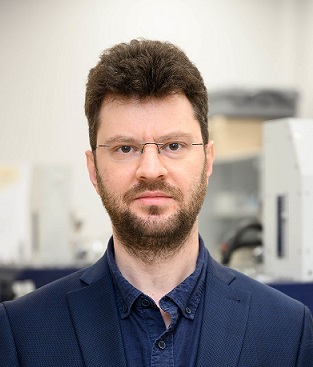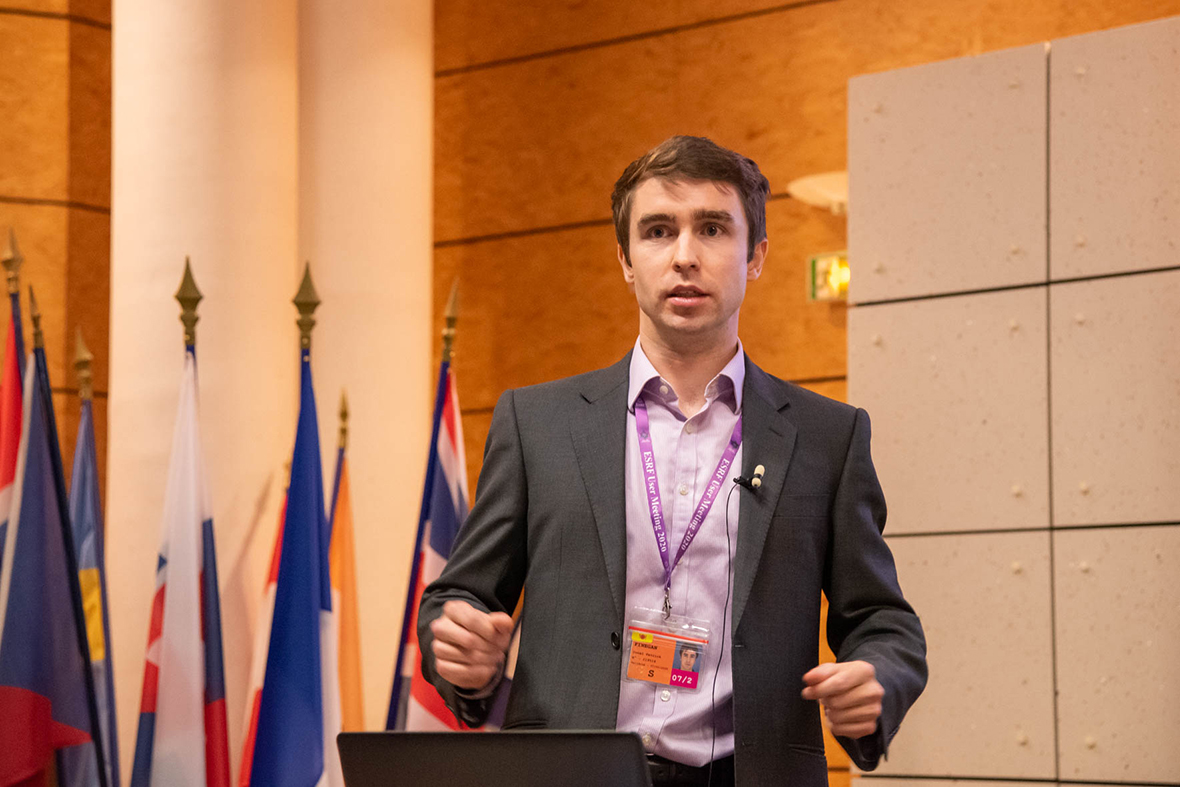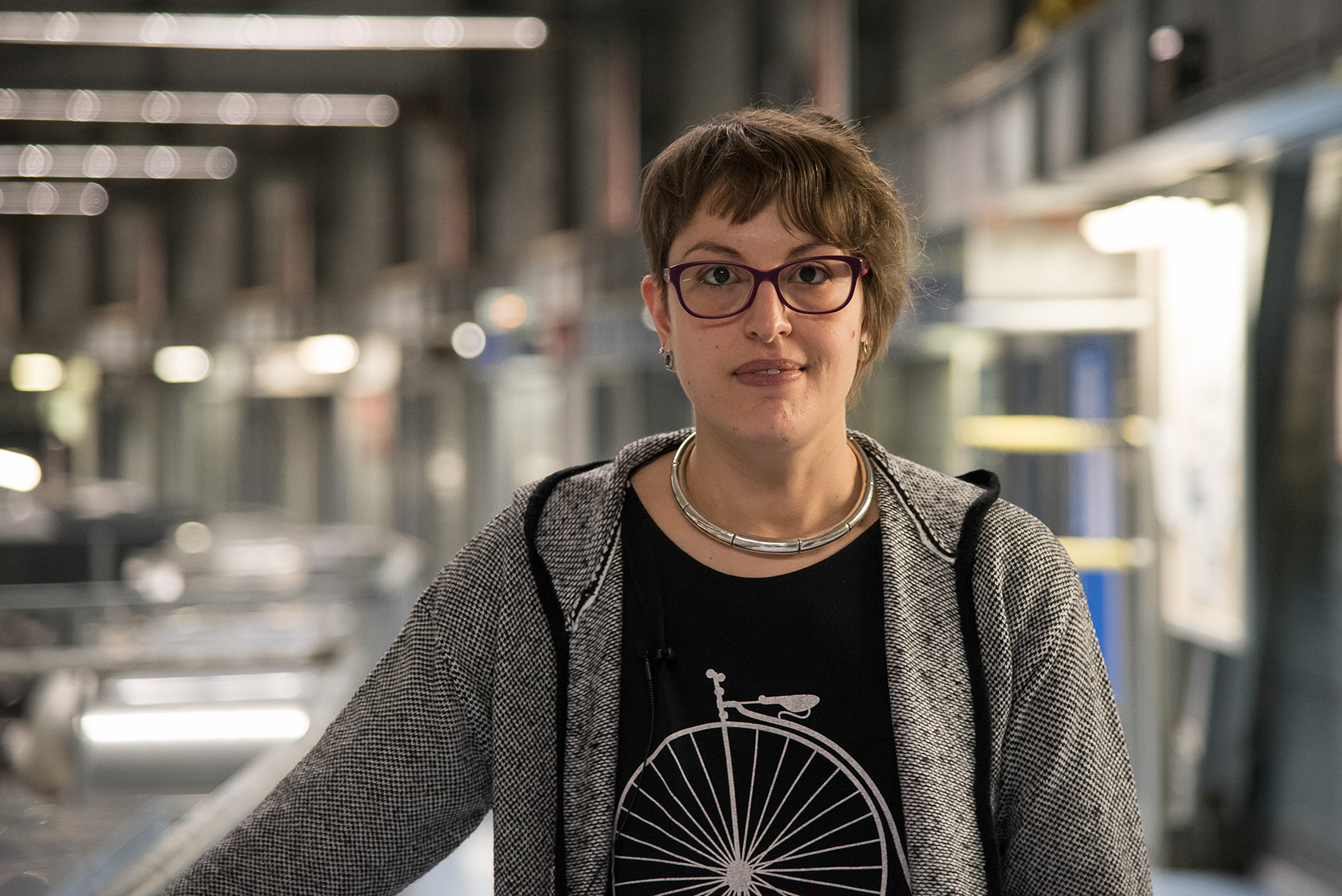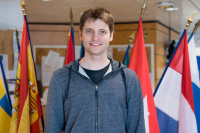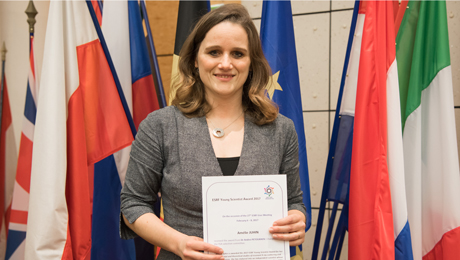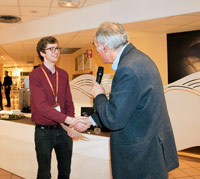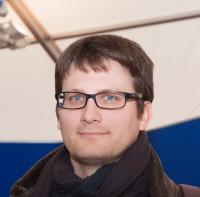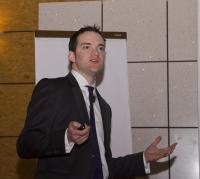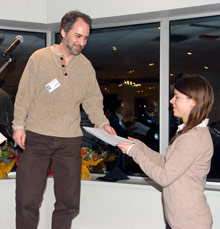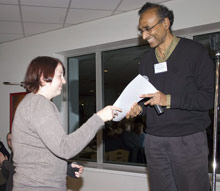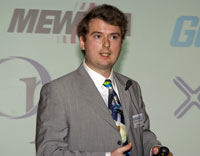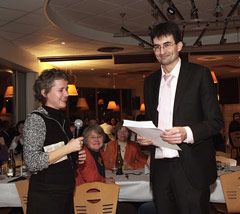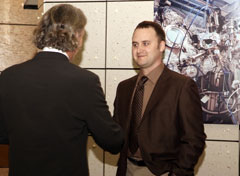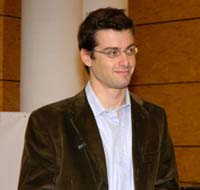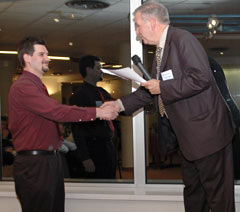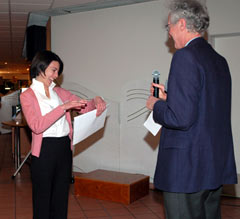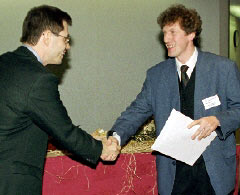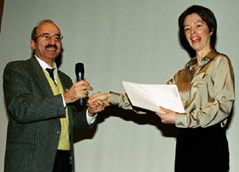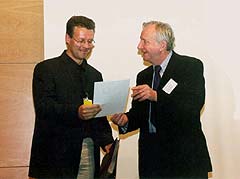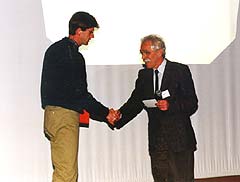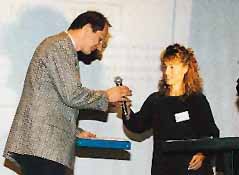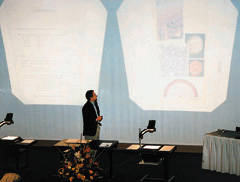- Home
- Users & Science
- ESRF User Organisation
- ESRF Young Scientist Award
ESRF Young Scientist Award
Current rules for nominations and selection
The ESRF Young Scientist of the Year Award is given every year by the Users Organisation for outstanding work done done by an ESRF user (ESRF staff included) at the ESRF facilities. The prize is presented during the annual ESRF User Meeting and the recipient is requested to give a talk at the plenary session.
- The call for nominations is during the autumn of the year preceding the award (e.g. autumn 2017 for the 2018 award)
- The nominee can be of any nationality, with 3-7 years of experience since completion of PhD (as stated on the PhD certificate) and less than 37 years old on January 1st of the year the award is granted
- Exemptions to these eligibility criteria (e.g. pregnancy, sick leave, etc.) will follow the rules set for the ERC Starting grant call
- The relevant research must have been carried out at the ESRF
- The award is intended for a single winner
- There will be no shared prize and dual nominations are not accepted
Further details will be given yearly with the call for award nominations.
Evaluation of the applications
Every year the User Organisation Committee is in charge of nominating a chairperson for the award. The chairperson is asked to form a committee whose members are selected according to impartiality criteria. The chairperson and committee members evaluate the applications and decide on the recipient of the Young Scientist Award. Upon request, the User Organisation Committee can assist the chair with the criteria for the award. The User Organisation Committee is not involved in the final decision.
Please note that no self-nominations are accepted.
List of recipients of the ESRF Young Scientist Award
|
Jessica McBeck |
2024On 6th February 2024, Jessica McBeck, a geologist and computer scientist from the University of Oslo in Norway, has been awarded the ESRF Young Scientist Award 2024 by the ESRF User Organisation "for her outstanding contribution to the understanding of multi-scale fracture network development in rocks.” Replay her presentation here. |
|
Tilman Grünewald |
2023On 7th February 2023, Tilman Grünewald, a materials scientist at the Institut Fresnel (CNRS / Aix-Marseille Université / Centrale Marseille) in France, has been awarded the ESRF Young Scientist Award 2023 by the ESRF User Organisation “for his outstanding contribution and scientific leadership in the development of X-ray diffraction techniques and their application to the understanding of biomaterials”. See video at: https://youtu.be/jKayk6H_yec |
|
Claire Walsh |
2022On 8th February 2022, Claire Walsh, from the University College London, Centre for Advanced Biomedical Imaging, has been awarded the Young Scientist Award by the ESRF User Organisation for her outstanding contribution to the study of human organs by hierarchical phase contrast tomography, and her contributions to understanding the microvascular architecture of lungs in severe COVID-19 cases. See video at: |
|
Valentin Borshchevskiy |
2021On 9th February 2021, Valentin Borshchevskiy, researcher at the Moscow Institute of Physics and Technology (MIPT), has been awarded the Young Scientist Award by the ESRF User Organisation for his outstanding contribution to the understanding of structure-based functional properties of membrane proteins. A regular user at the ESRF since 2005, he initiated the Beamtime Allocation Group (BAG) for Russia five years ago. |
|
Donal Finegan at the 2020 User Meeting |
2020On 4th February 2020, Donal Finegan, from the National Renewable Laboratory (Golden, USA), was awarded the title of Young Scientist 2020 by the ESRF User Organisation for his innovative research of the highest quality on a topic of great current academic and public interest, namely lithium ion battery failure and degradation. See video at: https://www.youtube.com/watch?v=Tjq_7Cmv0H8 |
|
Elisa Borfecchia at the 2019 User Meeting |
2019On 5th February 2019, Elisa Borfecchia, from the University of Turin in Italy, was awarded the title of Young Scientist 2019 by the ESRF User Organisation for the impressive results on selective catalysis that she obtained with extensive use of X-ray spectroscopy. See video at: https://www.youtube.com/watch?v=Z3VQulrMIg4 |
|
Kilian Heeg at the 2018 User Meeting |
2018The winner of the 2018 ESRF Young Scientist Award was Kilian Heeg, Postdoctoral Researcher at the Max Planck Institute for Nuclear Physics (Heidelberg, Germany) for his pioneering work on light-matter interactions enabling resonant brillance enhancement of X-ray pulses. See video at https://youtu.be/fZvaP7Ogt_o |
|
Amélie Juhin on receiving the award |
2017Amélie Juhin was presented with the Young Scientist Award 2017 at the 27th User Meeting on 7th February 2017. With the Award, Amélie was recognised for her experimental and theoretical studies of resonant X-ray scattering and X-ray dichroism. See video at: https://youtu.be/2gCE_QV5oxc |
|
Andrew Cairns receiving the award from Professor Massimo Altarelli. |
2016The Young Scientist Award was presented to Andrew Cairns at the 2016 ESRF User Meeting (8-10 February) for his ground breaking studies of negative linear compressibility (NLC). Materials exhibiting NLC were the focus of Andrew’s PhD thesis at the University of Oxford in the UK. Andrew is now a post-doctoral researcher at ESRF beamline ID27. |
|
Beatrice Ruta |
2015The 2015 Young Scientist of the Year award was presented to Beatrice Ruta at the 25th annual ESRF User Meeting (9-11 February 2015). Beatrice, a beamline scientist at the ESRF, was given the accolade for her work on the study of atomic dynamics in glasses. |
|
Mathieu Le Tacon |
2014At the annual ESRF Users Meeting from 3-6 February, the Users Organisation declared solid state physicist Mathieu Le Tacon, aged 33, winner of the Young Scientist Award for his outstanding work on a new electronic phase of cuprates that competes directly with superconductivity. |
|
Simon Kimber during his talk at the plenary session of the 2013 Users Meeting. |
2013At the 23rd Users Meeting on 6th February, Federico Boscherini awarded Simon A.J. Kimber the 2013 Young Scientist Prize for his outstanding work on X-ray pair distribution function techniques (PDF) and their application to nanostructured materials. Simon carried out the work on ID15, the high energy beamline, during his post-doctoral studies there. |
|
Lawrence Margulies (BNL) presenting the Young Scientist Award to Irene Zanette (TUM) |
2012The Young Scientist of the Year Award was presented to Irene Zanette on 7 February 2012 during the annual ESRF Users Meeting. Irene was chosen for the award for her work on “The development of a 2D grating interferometer for directional dark-field and quantitative phase imaging and for the demonstration of low-dose methods for multimodal grating-based tomography.” These new techniques were developed at beamline ID19 while Irene was working on her thesis. Irene is now a postdoctoral researcher at Technische Universität München (Germany). |
|
Helen Walker receiving the Young Scientist Award from Dr V. Ramakrishnan. |
2011Helen Walker was presented with the Young Scientist Award at the ESRF Users Meeting on 8 February 2011 for her outstanding work on “Exotic types of low temperature ordering in complex materials”. Helen is a post-doctoral researcher at beamline ID20. She pioneered the use of both non-resonant and resonant X-ray scattering techniques to advance the current understanding of ordering mechanisms in multipolar ordered and multiferroic materials. |
|
Yaroslav Filinchuk. |
2010Yaroslav Filinchuk was the recipient of the prize in 2010 for “his outstanding work on the chemistry of solid state hydrides”. This Ukrainian chemist has worked at the Swiss–Norwegian Beamline (BM1) at the ESRF since 2006. He is currently a visiting professor at the University of Aarhus (Denmark). |
|
Gergely Katona receives his prize from Gerlind Sulzenbacher, head of the Users Organisation. |
2009Gergely Katona was awarded the prize for his innovative experiments in the field of structural dynamics of proteins using synchrotron radiation. While working at IBS (Grenoble) he helped to introduce the technique of Raman spectrometry to the cryobench, allowing the energy of frozen intermediaries in biological processes to be read without damaging them with radiation. Katona is now an assistant professor at Gothenburg University, Sweden. |
|
Stuart Wilkins (right) being congratulated by Richard Neutze. |
2008The Brookhaven National Lab physicist Stuart Wilkins, formerly a scientist at the beamline ID20 at the ESRF, is the 2008 winner of the Young Scientist Award. This prize recognises “his work on X-ray scattering studies of strongly correlated systems, and in particular transition metal oxides”. |
|
|
2007Pietro Gambardella is the winner of the 2007 ESRF Young Scientist Award given by the ESRF Users Organisation. Pietro is a researcher at the Institució Catalana de Recerca i Estudis Avançats (ICREA) and Catalan Institute of Nanotechnology (ICN). The prize acknowledges his work on “the understanding of magnetic properties of low-dimensional systems using polarised X-ray Absorption Spectroscopy”. |
|
Paul Tafforeau receives the award from Prof. Freddy Adams (right), chairman of the award selection committee. |
2006The award of the 2006 Young Scientist prize went to Paul Tafforeau, for the application of X-ray synchrotron imaging to studies in paleontology. Paul Tafforeau presented his studies on ID19 and ID17, firstly of fossil teeth from a 35 million-year old primate, and inferences as to the primate's diet, and secondly the study of small fossil eggs and the imaging of the skeleton remaining inside the egg. |
|
Serena Margadonna receives the YSA prize from Philip Evans. |
2005An Italian scientist working at the University of Edinburgh, Serena Margadonna, won the 10th Young Scientist Award. She exploited high-resolution diffraction facilities at the ESRF to perform outstanding crystallographic work on complex materials, with special emphasis on molecular solids. She presented her work in her talk "A chemist’s adventures with synchrotron X-ray powder diffraction". |
|
Anton Plech (right) receives the prize from Keijo Hämäläinen, previous Chairman of the Users' Organisation |
2004Time-resolved X-ray scattering studies gained Anton Plech the 2004 Young Scientist Award. He was presented with the prize during the 14th ESRF Users' Meeting on 10 and 11 February 2004. Currently a researcher at the University of Konstanz, Anton took the first steps in his career at the ESRF, where he held a post-doctoral position at the ID09 beamline for 2 1/2 years. |
|
Claudia Dallera receiving the Young Scientist Award 2003 from Prof. Settimio Mobilio. |
2003At the 13th ESRF Users' Meeting on 12 February 2003, the Young Scientist Prize was awarded to Claudia Dallera, from the University Politecnico di Milano. Claudia, the first woman to receive the prize, began her research career at the ESRF. The prize recognises her outstanding contribution to instrumentation, spectroscopy and high-energy photoemission. |
|
Guillaume Fiquet (left) receiving the Young Scientist Award 2001 from Jens Als-Nielsen. |
2001At the 11th ESRF Users Meeting held on 19 February, 2001, Prof. Jens Als-Nielsen, who chaired the award committee, presented the Young Scientist Prize to Guillaume Fiquet, from the Université Paris VI. Guillaume described his work under the title "The Physics of the Earth's Interior". |
|
Richard Neutze (right) being congratulated by Malcolm Cooper on receiving the Young Scientist Award, 2000. |
2000The 10th ESRF Users Meeting was held on 8 and 9 February 2000. Since this was the 10th Users Meeting, the Users Organisation decided to offer a prize of 10 000 FF, twice the usual amount, to the winner of the Young Scientist Award, Richard Neutze, from the University of Uppsala. He presented results covering picosecond biology, picosecond chemistry, and simulations of the potential for femtosecond X-ray imaging. |
|
Peter Cloetens (left) receiving the Young Scientist Award from W. Schülke. |
1999At the 9th ESRF Users Meeting, held on 11 February 1999, the Young Scientist Prize of 5000 FF was awarded to Peter Cloetens, from the ESRF Topography beamline. Peter came to Grenoble in 1994 after graduating in engineering from the Vrije Universiteit Brussels. During experiments on BM5 he observed that objects with negligible absorption can be imaged in a monochromatic beam; over the following three years he explored this phenomenon both experimentally and theoretically, and exploited it to study a number of problems in materials science. Together with an Italian team he helped develop a wave-guide to produce a submicron coherent divergent source and hence the first magnetified phase contrast images. |
|
Michael Thoms receives his award from the hands of S. Pascarelli, Chairwoman of the Users' Organisation. |
1997The 8th ESRF Users Meeting was held on 21 November 1997, following the 4-day conference "Highlights in X-ray Synchrotron Radiation Research". The Young Scientist Award was made to Michael Thoms (Erlangen University) for the development of a new image plate detector, an order of magnitude faster than other detectors of this kind. This development can lead to unprecedented possibilities for new experimental techniques, such as the measurement of the kinetics of phase transitions and the study of single crystals subjected to extreme conditions. Michael described the work he performed at the ESRF which lead to the optimization of this detector, as well as some of the first results obtained at the high pressure beamline ID30, ending with an overview of other potential applications. |
|
Paul Loubeyre during his plenary lecture |
1996At the 7th ESRF Users Meeting, "Science at the ESRF", held on 18 November 1996, the Young Scientist Award was made to Paul Loubeyre (Université Paris VI) for the extension of single crystal X-ray diffraction above the Mbar, enabling the determination of the equation of state of hydrogen, of most fundamental interest and of great astrophysical relevance. Unique in its kind worldwide, the new experimental apparatus developed by P. Loubeyre has revealed the structural properties of a number of systems including H2, D2, He, LiH, H2O, Ar(H2)2 and Ar(O2)3. |
|
Francesco Sette during his talk at the Users Meeting 1995. |
1995At the 6th ESRF Users' Meeting held on 20 and 21 November 1995, and attended by some 300 participants, the first "Young Scientist Award" was made. This award, accompanied by a cash prize of 5 000 FF, was made to Francesco Sette (ESRF Inelastic X-ray Scattering Group) for the ground-breaking measurements, by inelastic scattering, of the collective excitations of water in previously inaccessible regions of the energy-momentum plane. These demonstrated the new scientific horizons opened up by his uncommon achievements in the construction of the very high resolution set-up on ID16 - performed in less than four years - and included the design, implementation and validation of many novel and daring technical concepts. |



